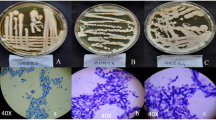Abstract
A strain of Candida famata was adapted to high copper concentration (1.26 mM) and a number of biochemical parameters have been tested, in order to get information on the mechanisms of metal toxicity and detoxification as well as on the metabolic responses to the treatment. The cytoplasmic levels of superoxide dismutase, peroxidase and glutathione were found significantly increased with respect to control cells, in contrast to catalase which is not affected. The activities of enolase and of triosephosphate isomerase are found to decrease as a consequence of the exposure to copper. Statistically significant differences in the content of some aminoacids are found between copper-treated and control cells.
Similar content being viewed by others
References
Adams RF. 1974 Determination of aminoacids profiles in biological samples by gas-chromatography. J Chromatogr 95, 189-212.
Anderson ME. 1985 Determination of glutathione and glutathione disulfide in biological samples. In: Meister A, ed. Methods in enzymology, New York: Academic Press: 13, 548-555.
Bayer E, Frank H, Gerhardt J, Nicholson G. 1987 Capillary gas chromatographic analysis of amino acids by enentiomer labeling. J Assoc OffAnalChem 70(2), 234-240.
Beutler E. 1984 A Manual of Biochemical methods in Red Cell Methabolism. New York: Grune and Stratton Inc.: 3rd ed.
Bilinski T, Litwinska J. 1987 On the ideas alternative to the theory of superoxide-mediated oxygen toxicity. Bull Polish Acad Sci 35, 25-31.
Butt TR, Ecker DJ. 1987 Yeast metallothionein and applications in biotechnology. Microbiol Rev 51(3), 351-364.
Cousins RJ. 1985 Absorption, transport, and hepatic metabolism of copper and zinc: special reference to metallothionein and ceruloplasmin. Physiol Rev 65, 238-309.
De Ming L. 1989 Capillary gas chromatographic analysis of amino acids in geological environments with electron capture detection. J HighResolChrom 12, 239-243.
Etcheverry T, Forrester W, Hitzeman R. 1986 Regulation of chelatin promoter during the expression of human serum albumin or yeast phosphoglycerate kinase in yeast. Biotechnology 4, 726-730.
Fahey RC, Sundquist AR. 1991 Evolution of glutathione methabolism. Adv Enzymol Relat Areas Mol Biol 64, 1-53.
Freedman JH, Ciriolo MR, Peisach J. 1989 The role of glutathion in copper metabolism and toxicity. J BiolChem 264, 5598-5605.
Fridovich I. 1989 Superoxide dismutases. An adaptation to a para-magnetic gas. J Biol Chem 264, 7761-7764.
Galiazzo F, Schiesser A, Rotilio G. 1988 Oxygen independent induction of enzyme activities related to oxygen metabolism in yeast by copper. Biochem Biophys Acta 965, 46-51.
Germann UA, Lerch K. 1987 Copper accumulation in the cell-wall-deficient slime variant of Neurospora crassa. Comparison with a wild type strain. Biochem J 245, 3678-3670.
Husek P, Macek K. 1975 Gas chromatography of amino acids.J Chromatography 113, 139-230.
Karin M, Najarain R, Haslinger A, Valenzuela P, Welch J, Fogel S. 1984 Primary structure and transcription of an amplified genetic locus: the CUP1 locus of yeast. Proc Natl Acad Sci 81, 337-341.
Lerch K. 1980 Copper metallothionein, a copper-binding protein from Neurospora crassa. Nature 284, 3678-3700.
Lowry OH, Rosenbrough NJ, Farr AL, Randall RJ. 1951 Protein measurement with the Folin phenol reagent J BiolChem 193, 265-275.
Mc Cord JM, Keele BB, Fridovich I. 1971 An enzyme based theory of obligate anaerobiosis, the physiological functions of superoxide dismutase. Proc Natl Acad Sci (USA) 68, 1024-1027.
Mac Kenzie SL, Tenaschuk D. 1974 Gas-liquid chromatography of N-heptafluorobutyryl isobutyl esters of aminoacids. J Chromatography 97, 19-24.
Michelson AM, Puget K, Durosay P, Nonneau JC. 1977 Clinical aspects of the dosage of erytrocuprein. In: Michelson AM, Mc Cord JM, Fridovich I eds. Superoxide and superoxide dismutase. London: Academic Press 467-499.
Niederweiser A. 1975 Chromatography, E. Heftmann Ed. New York: Van Nostrand Reinhold. Vol. II, 393.
Puget N, Michelson AM. 1974 Iron containing superoxide dismutase from luminous bacteria. Biochimie 56, 346-356
Puget N, Michelson AM, Avrameas S. 1977 Light emission techniques for the microestimation of femtogram levels of peroxidase. Anal. Biochem. 79, 447-456
Romandini P, Tallandini L, Beltramini M, Salvato B, Manzano M, de Bertoldi M, Rocco GP. 1992 Effects of copper and cad-mium on growth, superoxide dismutase and catalase activities in different yeast strains. Comp Biochem Physiol 103 (C), 255-262.
Rose AH, Veazey FJ. 1988 Membranes and lipids of yeasts. In: Campbell I, Duffus JH. eds. Yeast a practical approach. Oxford: IRL Press. 255-275.
Sarais I, Manzano M, de Bertoldi M, Romandini P, Beltramini M, Salvato B, Rocco GP. 1994 Adaptation of a Saccharomyces cerevisiae strain to high copper concentration. Biometals 7, 221-226.
Steinebach OM, Wolterbeek HT. 1994 Role of cytosolic copper, metallothionein and glutathione in copper toxicity in rat hepatoma tissue-culture cells. Toxicology 92, 75-90.
Stadtman ES. 1990 Metal ion-catalyzed oxidation of proteins: bio-chemical mechanisms and biological consequences. Free Radical Biology & Medicine 9, 315-325.
Stadtman ER, Oliver CN. 1991 Metal-catalyzed oxidation of protein. J Biol Chem 266, 2005-2008.
Stocchi V, Cardoni P, Piccoli G, Cucchiarini G, De Belli G, Dachà M. 1994 High resolution of multiple forms of rabbit reticulocyte hexokinase type I by hydrophobic interactin chromatography. J Chromatography 676, 51-63.
Thiele D. 1988 ACE1 regulates expression of the Saccharomyces cerevisiae. metallothionein gene. Mol Cell Bio l8, 2745-2752.
Tohoyama H, Inouhe M, Joho M, Murayame T. 1995 Production of metallothionein in copper and cadmium resistant strain of Saccharomyces cerevisiae. J Industr Microbiol 14, 126-131.
Tran LT, Miki T, Kamakura M, Izawa S, Tsujimoto Y, Miyabe S, Inoue Y, Kimura A. 1995 Oxidative stress-response in Yeast-Introduction of glucose-6-phosphate-dehydrogenase by lipid hydroperoxide in Hansenula mrakii. J FermBioe 80, 606-609.
Viarengo A, Nott JA. 1993 Mechanisms of heavy metal cation homeostasis in marine invertebrates. Comp Biochem Physiol 104(C), 355-372.
Weinstein B. 1966 In: Methods of Biochemical Analysis,NewYork: John Wiley & sons: 14, 203.
Wilkinson L. 1990 Systat, The system for statistic. Evanston, Inc.
Author information
Authors and Affiliations
Rights and permissions
About this article
Cite this article
Manzano, M., Cocolin, L., Citterio, B. et al. Biochemical responses in a Candida famata strain adapted to high copper concentrations. Biometals 13, 251–259 (2000). https://doi.org/10.1023/A:1009218621588
Issue Date:
DOI: https://doi.org/10.1023/A:1009218621588




